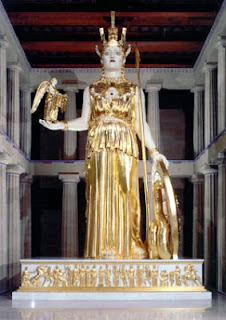By Lott Gwin
 First, a note on the term “neck amphora.” The Greek word amphora is a combination of amphi
(“on both sides”) and pher-/phor-
(meaning “carry”). Thus, the word refers
to a vessel with handles on both sides; it was often used to carry and store
wine. The vase depicted here is called a
neck amphora because its handles are placed on the “neck” (thinner upper
section) of the jar rather than on the “belly” (thicker, rotund section under
the neck). These jars are sometimes decorated with scenes from myth. The one shown here is late archaic (it dates
to about 500 BC) and is painted in the black-figure technique. It is attributed to the Diosphos Painter, who
was active in Athens from ca. 500-475.
First, a note on the term “neck amphora.” The Greek word amphora is a combination of amphi
(“on both sides”) and pher-/phor-
(meaning “carry”). Thus, the word refers
to a vessel with handles on both sides; it was often used to carry and store
wine. The vase depicted here is called a
neck amphora because its handles are placed on the “neck” (thinner upper
section) of the jar rather than on the “belly” (thicker, rotund section under
the neck). These jars are sometimes decorated with scenes from myth. The one shown here is late archaic (it dates
to about 500 BC) and is painted in the black-figure technique. It is attributed to the Diosphos Painter, who
was active in Athens from ca. 500-475.
The Trojan war offered Greek vase painters and other artists
ample material (for an overview, see S. Woodford, The Trojan War in Ancient Art [1993]). This vase shows two variations on the theme
of the removal of a great warrior’s corpse from the Trojan plain. In each case the warrior is an important ally
of the Trojans.
On the obverse we see the Thanatos (Death) and Hypnos
(Sleep) carrying away the corpse of the Lycian warrior Sarpedon – the subject
of another more famous late archaic red-figure vase, the Euphronius crater,
which was presented in a previous post (DATE).
Sarpedon, the son of Zeus, was killed in battle by Achilles’ friend
Patroclus. According to Iliad 16, Zeus expressed his grief by
crying tears of blood. The painter has
added a number of details. Blood oozes
from the wounds in Sarpedon’s limp body.
As for the deities, they are not the spectacular winged beings of Euphronius’
painting (found HERE). Instead, they each wear a chiton, corselet,
greaves, and a Corinthian helmet; they each carry a spear. In other words, they are represented as
ordinary warriors. The small winged
figure between them is the psyche or
soul of Sarpedon flying away. Readers of
the Iliad will recall how the soul is
said to float free from the body at the moment of death and flutter off to
Hades (cf. e.g. Iliad 22.361-2).

On the reverse Memnon is being carried off the battlefield
by his mother Eos, goddess of the dawn.
Memnon was slain by Achilles (possibly the figure on the left) in single
combat. Achilles fought on behalf of
Nestor to avenge the death of Nestor’s son Antilochus at the hands of
Memnon. Nestor would have fought Memnon
himself, had he not been too old. Eos
has large wings and is shown aloft. She
wears a chiton, a mantle, and a necklace.
The bird in the upper right-hand corner may stand for the Memnonides,
the companions of Memnon who were turned into birds by Eos; it is said that
they came every year to lament at his grave.
Eos, for her part, shed tears for him every morning: this is an
aetiology for the drops of dew that appear at dawn.
Sources:
Dietrich von Bothmer, “Euphronios and
Memnon. Observations on a Red-Figure Fragment,” Metropolitan Museum
Journal 22 (1987) 5-11.
Moore, Mary B., and Dietrich von Bothmer, Attic Black-Figured Neck-Amphorae, Corpus Vasorum Antiquorum, Fascicule 4 (1976) 67-68.

























